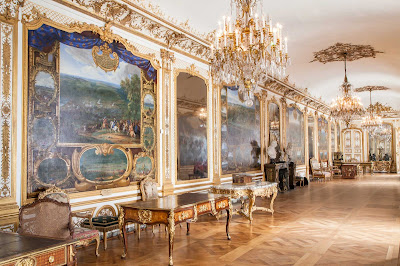An historic
monument since 1988, it is open to the public. The château's art gallery, the
Musée Condé, houses one of the finest collections of paintings in France. It
specialises in French paintings and book illuminations of the 15th and 16th
centuries.
The Château
de Chantilly at the time of the Grand Condé
The
estate's connection with the Montmorency family began in 1484. The first
mansion (no longer in existence, now replaced by the Grand Château) was built,
between 1528 and 1531, for Anne de Montmorency by Pierre Chambiges. The Petit
Château was also built for him, around 1560, probably by Jean Bullant. In 1632,
after the death of Henri II de Montmorency, it passed to his nephew, the Grand
Condé, who inherited it through his mother, Charlotte Marguerite de
Montmorency.
Molière's
play, Les Précieuses ridicules, received its first performance here in 1659.
Madame de Sévigné relates in her memoirs that when King Louis XIV of France
visited there in 1671, François Vatel, the maître d'hôtel to the Grand Condé,
committed suicide when he feared the fish would be served late. The collection
includes important works of the cabinetmaker André-Charles Boulle.
The
Château's library
The original
mansion was destroyed in the French Revolution. It was repaired in a modest way
by Louis Henri II, Prince of Condé, but the entire property was confiscated
from the Orléans family, between 1853 and 1872, during which interval it was
owned by Coutts, an English bank. Chantilly was entirely rebuilt, between 1875
and 1882, by Henri d'Orléans, duc d'Aumale (1822–1897) to the designs of Honore
Daumet. The new château met with mixed reviews. Boni de Castellane summed up
one line of thought: "What is today styled a marvel is one of the saddest
specimens of the architecture of our era — one enters at the second floor and
descends to the salons". In the end, the Duc d'Aumale bequeathed the
property to the Institut de France upon his death in 1897.
21st
century restoration
The World
Monuments Fund included the site in the 1998 World Monuments Watch to call
attention to water infiltration and high humidity in the Galerie des Actions de
Monsieur le Prince and again in the 2002 World Monuments Watch due to the precarious
condition of the entire estate. Funding for restoration work was provided from
various sources, including American Express and the Generali Group.
Subsequently,
in response to an appeal for the restoration of the château, The Aga Khan
donated €40 million, accounting for more than half of a €70 million needed by
the Institut de France to complete the project. In 2008 the World Monuments
Fund completed the restoration of the Grande Singerie, a salon with paintings
on the walls of monkeys engaged in human activities, once a fashionable salon
motif, but with few examples surviving today.
The hall of
honour
Works in
the art gallery (many of them are in the Tribune Room) include Sassetta's
Mystic Marriage of St. Francis, Botticelli's Autumn, Piero di Cosimo's Portrait
of Simonetta Vespucci, Raphael's Three Graces and Madonna of Loreto, Guercino's
Pietà, Pierre Mignard's Portrait of Molière as well as four of Antoine
Watteau's paintings and Jean-Baptiste-Camille Corot's Le concert champêtre.
Other paintings in the collection include works by Fra Angelico, Filippino
Lippi, Hans Memling, 260 paintings and drawings by François and Jean Clouet,
Veronese, Barocci, Annibale Carracci, Domenichino, Salvator Rosa, Nicolas
Poussin, Philippe de Champaigne, Van Dyck, Guido Reni, Jean-Baptiste Greuze,
Joshua Reynolds, Eugène Delacroix, Ingres, Géricault.
The library
of the Petit Château contains over 1,500 manuscripts and 17,500 printed
volumes, that is part of the collection of over 700 incunabula, and some 300
medieval manuscripts, including one page of the Registrum Gregorii (c. 983),
the Très Riches Heures du Duc de Berry, the Ingeborg Psalter and 40 miniatures
from Jean Fouquet's Book of Hours of Etienne Chevalier. Also in the museum's
collection is the Chantilly codex (MS 564), the primary manuscript of ars
subtilior music.
The main
French formal garden, featuring extensive parterres and water features, was
laid out principally by André Le Nôtre for the Grand Condé. The park also
contains a French landscape garden with a cascade, pavilions, and a rustic
ersatz village, the Hameau de Chantilly. The latter inspired the Hameau de la
reine of Marie Antoinette in the Gardens of Versailles.
The estate
overlooks the Chantilly Racecourse and the Grandes Écuries (Great Stables)
which contains the Living Museum of the Horse. According to legend, Louis
Henri, Duc de Bourbon, Prince of Condé believed that he would be reincarnated
as a horse after his death. In 1719, he asked the architect Jean Aubert to
build stables suitable to his rank.

















No comments:
Post a Comment